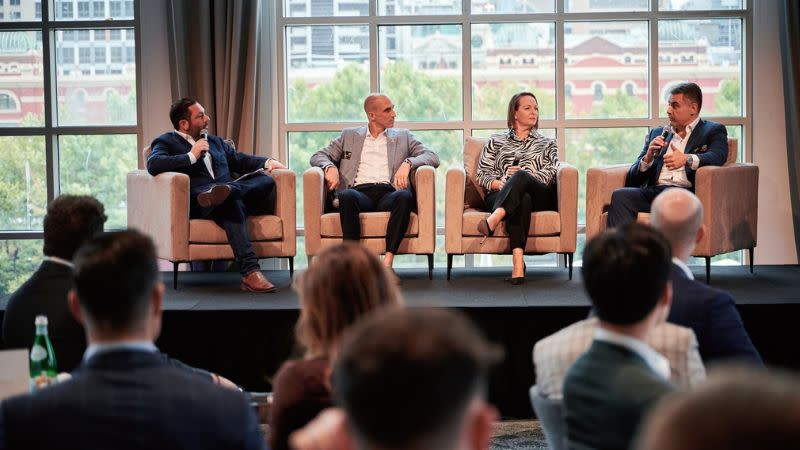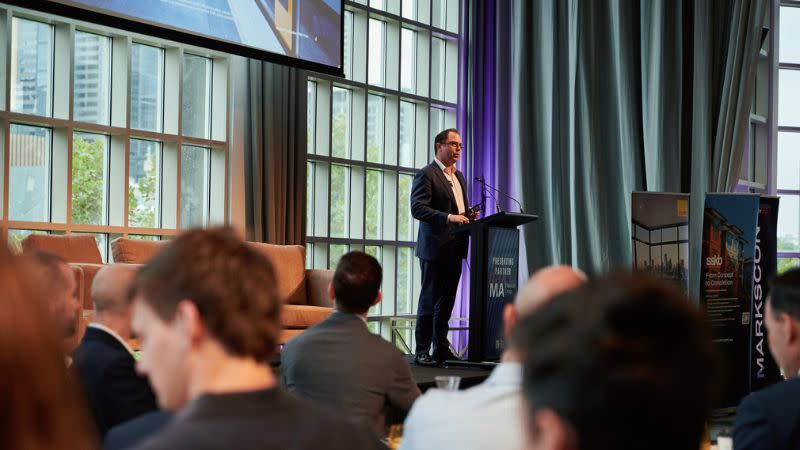
“Someone else has already learned all those lessons, so why repeat them?”
Assemble chief executive Carolyn Viney’s words were a throughline at The Urban Developer’s 2025 Property Outlook event in Melbourne,
And that outlook is promising for Victoria, according to KPMG’S Terry Rawnley who said both the recent rate cut and Stage 3 tax cuts had restored some confidence for the industry.
There are, however, concerns around costs and the uncertainty created by upcoming state and federal elections, as well as the potential ramifications of international politics, he told the audience.
“I think the interest rates are really about confidence and certainty,” Rawnley said.
“People don’t like the uncertainty of elections, so once we sort of clear out the Western Australian and federal election, businesses across the country will go: ‘Okay, we know who’s in power. We know what their priorities are. Let’s get out there’.”

And on the subject of uncertainty, during a panel discussion with sector leader, how to prepare for the expected and less expected was in focus.
That included increasing construction costs, and suppliers and subcontractors insolvencies.
Hickory Group’s managing director George Abraham said it paid to be proactive in supporting subcontractors and suppliers.
“The thing that we don’t talk about too much [is] the rate of insolvency,” Abraham said.
“Rather than wait for it to happen, [we] try to put some processes in place to forecast and diagnose where it might happen.”
Being involved was important, he said.
“Don’t be afraid to roll your sleeves up and intervene when possible, because the difference between a subcontractor falling over and not is giving them support that you don’t have to, and ... the health of our business and our industry will continue to rely on that.”
Prefabrication and modular work are also part of Hickory’s tools, allowing the company to be more efficient, reducing risk and increasing sustainability.
“The lowest lying fruit is waste minimisation,” Abraham said.
“Your only real chance of minimising waste is by doing it off site, in a controlled environment, from a 3D model that’s designed to a millimeter of its existence.
“Pre-fabrication enables that.”
Developer Assemble’s Caroline Viney said efficiency was crucial for there projects to to cater to the low to middle income market.
Reducing the number of core component specifications so that the same specifications were used across projects was one such efficiency.

“It doesn’t need to be exactly this, because it doesn’t need to be a cookie cutter that every building is the same, but some of the core components will save you time, will save you money,” Viney said.
Viney also said that managing and operating assets as well as developing them changed the design process.
“We’re thinking about, we’re going to be managing tens of thousands of these homes,” Viney said.
“And while the construction development phase is a super important part of our business, it’s the 30 years that we’re going to manage those assets for, on behalf of investors, where the incremental return is going to be really important.”
And despite it dragging the chain nationally, there is still opportunity in city’s office sector, Alfasi managing director Gill Dvir said.
“There’s going to be less office being developed,” Dvir said, “and refurbishment is creating opportunity too.
“B and C grades are going to [remain] problematic, so if you can ... upgrade buildings, that’s a very good opportunity.”
Dvir said financing for office projects could still be found.
“You have to find the right home for it,” he said, adding that non-bank lenders are “still very hungry” and still believed in good product.
Dvir predicted the office market would bounce back in 2027.
“There is two, three years before we really see the office market come back to what it was a few years ago,” he said.
“But ... with less development, less stock, some mandating [of people going] back to work ... I think by 2027 rents will go up.”
Viney and Abraham were optimistic about the future of development in Victoria.
“You have to be under a rock if you haven’t ... come to understand that we’ve got a critical shortage and an undersupply of housing,” Viney said.
“So whatever we’re doing as a country for the next 10 years involves building lots of homes, and we finally have both government policy and government funding to get around that issue.”
Abraham said it came down to what made Melbourne, Melbourne.
“The fundamentals of what made this city the most livable city for a very long time still exist,” Abraham said.
“We are still the same place, if not better, in so many ways.
“And you know, along with everything else we mentioned, I definitely feel we’re back on an upwards trajectory.”